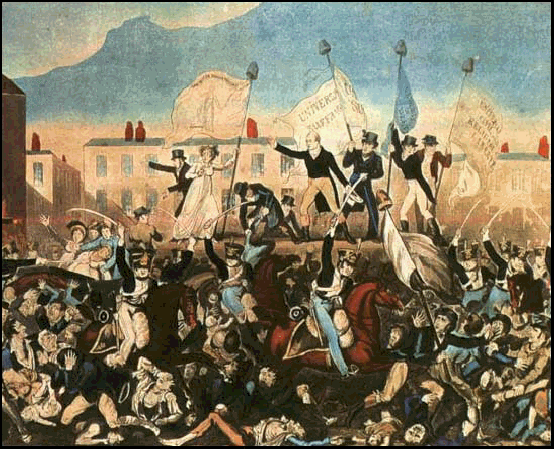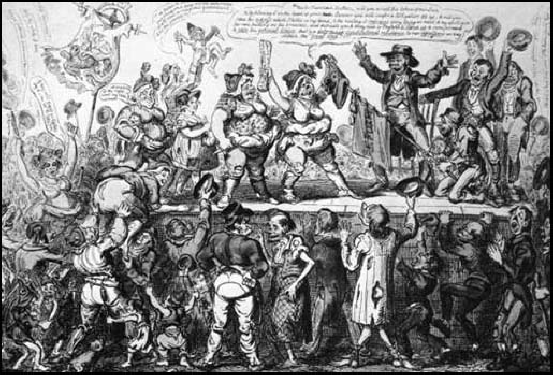Popular Political Pressure
POPULAR POLITICAL PRESSURE 1795-1820
Introduction
After the end of the French Wars England was suffering from great social, economic and political upheavals collectively known as the 'Condition of England Question'. This unrest differed from the earlier radical movements: the numbers were greater; organisation of the movement was more widespread; heartland of radicalism had moved to the industrial districts of the midlands and the north; face of popular radicalism was more working class. The character of disputes in the late eighteenth and early nineteenth century take two guises: those which are mainly or wholly industrial or economic in nature and include strikes and food riots and the few that are primarily political or insurrectionary disputes. There is considerable overlap between the two and this has led to historians such as E P Thompson to claim that there was a revolutionary mood in Britain in the early decade of the nineteenth century.
Industrial disputes
Industrial disputes were common in the early decades of the nineteenth century. In 1797 there were naval mutinies after demands for higher pay were ignored. E P Thompson has observed that widespread mutiny in the fleet provided opportunities for those with grievances over pay and those with political claims, In 1802 the London shipwrights conducted a prolonged dispute in which they used intimidation to prevent strike breakers being brought in from the Royal shipyards. These early disputes were test beds for Luddism which occurred on a wide scale from 1811. The outbreaks of machine breaking began in the stocking frame industry and their distinguishing features were letters and proclamations bearing the signature Ned Ludd, King Ludd or General Ludd - the name of a (perhaps) mythical individual, Ned Ludd who was reputed to live in Sherwood Forest. Three main trades were affected: the framework knitting trade in Nottinghamshire, Leics and Derbys; the woollen industry in Yorks and the cotton industry in Lancs and Cheshire. Between March 1811 and February 1812 they smashed about a thousand machines at the cost of between £6,000 and £10,000. In April 1812, the Luddites attacked William Cartwright's mill at Rawfolds near Huddersfield. The event was described by Charlotte Brönte in her novel Shirley. There have been various interpretations of Luddism. Some analyses place it in the context of earlier instances of ‘collective bargaining by riot’. E P Thompson views Luddism as a quasi-political movement which had ‘ulterior revolutionary objectives’. Rule in Labouring classes counters this view arguing that Luddism was primarily an industrial movement. Luddism varied from region to region and industry to industry so it is difficult to get a definitive answer about its political and industrial nature. It did coincide with the assassination of Spencer Perceval which was greeted with jubilation in some working class areas and thus must be seen as having tapped into the popular mood which was anti-government and anti-employer.
Peterloo
Events of 16th August 1819 in Manchester when eleven people were killed and about 400, including 100 women, were wounded.
The use of the press is important. Richard Carlile avoided being arrested and after being hidden by local radicals, he took the first mail coach to London. The following day placards began appearing in London with the words: 'Horrid Massacres at Manchester'. He also produced a print of the action (see below) Newspapers also used eye-witness accounts by moderate radicals including Archibald Prentice:
The morning of the 16th of August came, and soon after nine o'clock the people began to assemble. From the windows of Mr. Baxter's house in Mosley-street, I saw the main body proceeding towards St. Peter's Field, and never saw a gayer spectacle. There were haggard-looking men certainly, but the majority were young persons, in their best Sunday's suits, and the light coloured dresses of the cheerful tidy-looking women relieved the effect of the dark fustians worn by the men. Slowly and orderly the multitudes took their places round the hustings, which stood on a spot now included under the roof of the Free Trade Hall, near its south-east corner. Our company laughed at the fears of the magistrates, and the remark was, that if the men intended mischief they would not have brought their wives, their sisters, or their children with them. I saw Hunt arrive, and heard the shouts of the sixty thousand persons by whom he was enthusiastically welcomed, as the carriage in which he stood made its way through the dense crowd to the hustings. I proceeded to my dwelling-house in Salford, intending to return in about an hour or so to witness in what manner so large a meeting would separate. I had not been at home more than a quarter of an hour when a wailing sound was heard from the main street, and, rushing out, I saw people running in the direction of Pendleton, their faces pale as death, and some with blood trickling down their cheeks. It was with difficulty I could get any one to stop and tell me what had happened. The unarmed multitude, men, women, and children, had been attacked with murderous results by the military.
The role of women was not unusual but what was unique was the scale of their mobilisation in the radical protests of this period: they voted at meetings, formed associations with female officers, held their own meetings and presented addresses. Women were claiming the right to inclusion within the political nation. Loyalist and government commentators rejected the radicals claims that women gave a moral tone to protests and seized on the incidence of Blackburn female reformers presenting a cap of liberty a month before Peterloo as an example of their lax manners and morals. (see print below)
Peterloo hardened political positions. The government were left with no option but to defend the actions of the magistrates. When parliament reassembled a new battery of repressive measures, the Six Acts were passed. The Whigs who condemned the action of the troops were able to broaden their base of support and to cash in on popular feelings. Peterloo received enormous publicity and the blunders had been carried out in full view of the radical, active, provincial press. James Epstein has noted that the use of the ‘cap of liberty’ and other signs and gestures such as carrying branches of laurel and playing music such as Rule Britannia and God Save the King illustrate the change from Paineite republicanism to popular constitutionalism.
The Queen Caroline Affair, 1820
The affair involved unprecedented levels of female participation. There was an extraordinary campaign by the ordinary women of Britain in support of the queen. Addresses were signed in large numbers including by 14,000 Bristol women, 17,600 married women from London and 3,700 ‘ladies’ from Halifax. The documents reiterated the Queen’s virtue, attacked George IV for seeking to legitimise the double standard and expressed fears that a royal divorce would compromise the marital security of all women. The connection that Burke drew 30 years before between the treatment of Marie-Antoinette and the rottenness of French government was revived against the Tory government and George IV therefore linking a range of popular causes: the double standard, corruption, radicalism and popular conservatism.
The Queen Caroline affair was the most genuinely popular cause of the early 1820s. The cause was successful in agitating not only the radicals and the mob but also the whole population of ‘respectable’ conservative opinion and the many women who supported Caroline. Anna Clarke argues that the affair was the last ‘spectacular eruption of transgressive, unruly, plebeian radicalism’ which would be replaced by the new sobriety of working class politics. The move to more formal politics as well as the boost the affair gave to loyalism perhaps helps to explain the decline in the pressure for reform between the mid-1820s and 1830.


